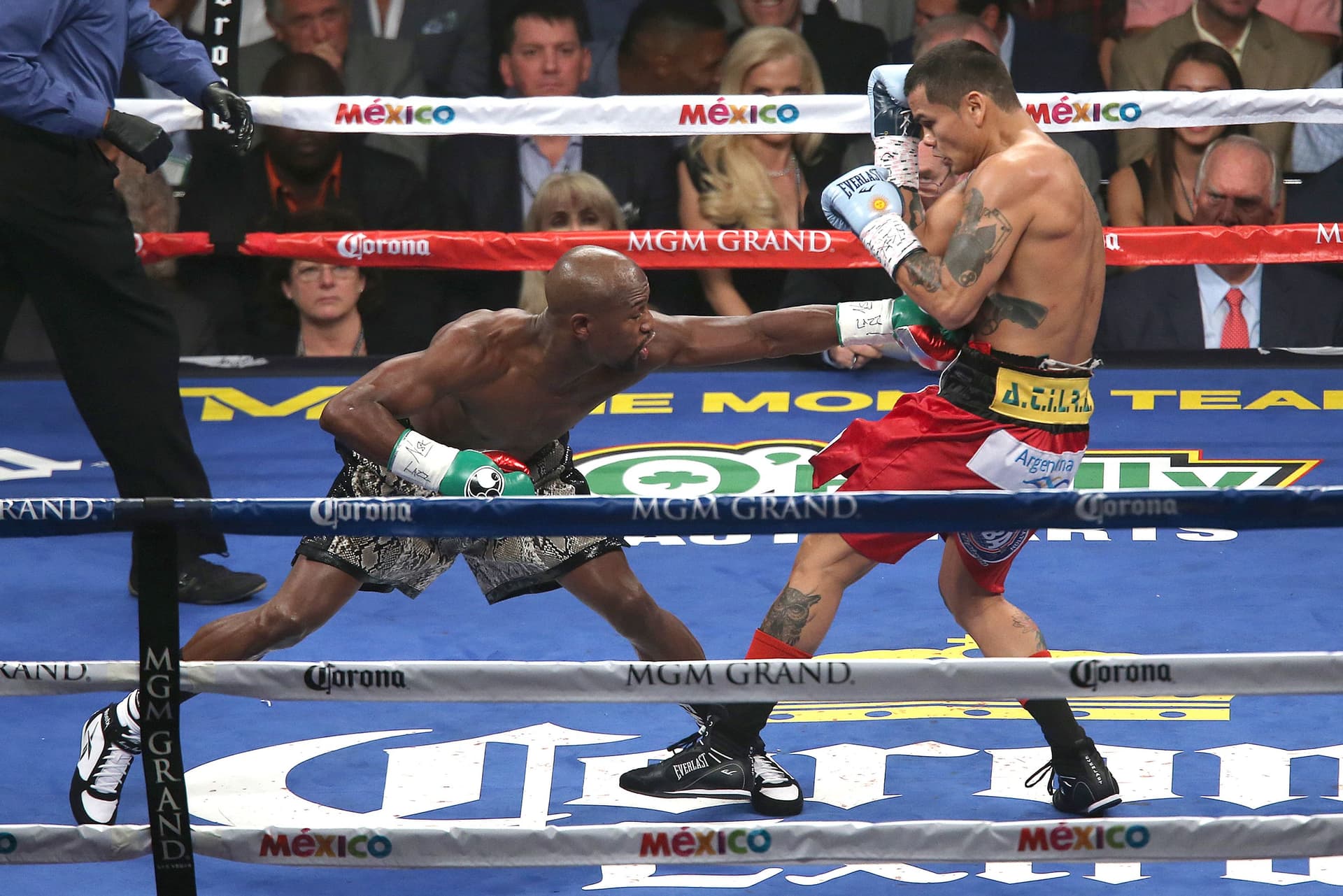Boxing
Types of Punches in Boxing
There are only a few different punches in boxing, but lots of variations. Discover what they are in our expert guide to punches.

Floyd Mayweather Jr. and Marcos Maidana//Getty Images
The four main types of punches in boxing
There are just four groups of punches in boxing, but many more that offshoot from that.
There’s multiple different versions of jabs, crosses, hooks and uppercuts, and they all have different uses, techniques and results.
Read on to find out more about our guide of punches, their uses, results, and how to use them effectively.
The Jab
“The right hand can take you around the block, but the jab will take you around the world.” This well-known quote demonstrates just how important this punch is.
The jab is the most valuable, most used, and also the most technical of all punches in boxing.
It’s also called the lead hand, because the jab comes from the front shoulder of the angled stance. Therefore, it has the shortest distance to travel and requires less energy and power than using the back hand. It also doesn’t leave the boxer too exposed, off-balance or out of position.
It’s used for a multitude of purposes – to gauge distance, collect data, create openings, cause damage, and also helps to defend against opponents.
It can be used for offence and defence, with or without speed and power, and is by far the most commonly used punch in boxing.
There’s a variety of ways to throw a jab, all with different results…
Basic Jab: The basic jab is the standard jab whilst standing still, easy to throw without comprising defence.
Step-in Jab: For a jab with added power, a boxer can take a step forward at the exact same time as throwing, leading to a far more powerful shot. This jab can also take opponents by surprise. The downside is that it requires leaping in from out of range, which is always a risky move.
Backstep Jab: The backstep jab is a defensive move. When an opponent advances forward, a boxer can extend their lead arm to maintain a safe distance between them. The cons to this jab is that there’s minimal power to it.
Throwaway Jab: This punch may sound pointless from the title, but it’s designed to set up the next shot. Naoya Inoya is a master of using a throwaway jab to instantly set up a knockout shot straight after it. It was the throwaway jab to the body that set up the overhand right for Canelo to knock out Amir Khan with.
Pawing Jab: A defensive move is to paw at opponents with the lead hand, which involves extending the jab hand outwards, constantly waving in the face of the opponent, distracting them from being able to see fully or throw back. While the jab hand is waving in their face, not only can the boxer make things extremely awkward and difficult for the opponent, but they can also land short shots that are hard to react to while their hand is so close to the face.
Flicking Jab: Also known as the ‘up jab’, a boxer can hang their lead hand down low by their hip, or even lower by their leg or knee, and then flick it upwards with a snap. This is awkward for the opponent because the hand is so low it’s operating out of their vision and the way that it snaps upwards can be too awkward and fast to defend against. The downside is that the boxer throwing will have an entire side of their body and face completely open.
Corkscrew Jab: This jab is designed to penetrate through a tight guard. When throwing a jab correctly, there will always be a twist when at full extension, which not only offers a little snap to the punch, but also results in that extra inch in reach too. A corkscrew jab is just an intensified version of that snappy jab with extra twist and rotation in the wrist to slip through that solid guard with a slimmer angle of a glove that’s turned 90 degrees.
The Cross
The cross is a rear straight punch that comes across the body. Depending on whether the boxer is orthodox or southpaw, the cross always comes form the back hand, so it involves the rotation of the whole body.
To throw effectively, the back hand has to be extended fully, which requires the rotation of the shoulder and hips forward. Because of this movement, there is far more power incorporated into this punch when compared to the lead jab.
The better the technique, torque, timing and speed, the more power generated.
Quite often, the cross is followed on from the jab, a combination known as the ‘one-two’. The cross does usually come off another punch, most commonly the jab, but when thrown as a lead hand, it can be surprising to the opponent, who will be expecting the jab first.
The cross is a punch quite frequently used, because, similarly to the jab, it can be thrown without leaving the boxer too exposed. To throw this shot, the boxer does have to extend themselves to commit to it, leaving themselves open, but if their lead hand is tucked up nice and tight then they won’t be too exposed.
The Hook
The hook is arguably the most powerful of all punches. The punch is thrown at a 90-degree angle, with an arm bent into the shape of a hook that comes around the side, as opposed to straight punches like the jab and cross.
To generate maximum power, the boxer has to rotate their hips, transfer power from their legs, and whip the shot from around the side.
The hook can have devastating effects, but the boxer must commit fully, leaving themselves exposed and out of shape. The rear hook obviously leaves the boxer even more open than the lead hook, because it requires even more rotation.
Because the rotation involved in the hook leaves the boxer turned to the side, it’s quite often used in a combination of punches that will allow the boxer to reset back into their starting stance. Or the boxer will follow the hook with a roll to produce the same result.
Mike Tyson was known for the effective use of his hooks. He mastered the style of bobbing and weaving from side to side with full extension in his hips to throw his hooks with maximum power generated from his twisting and turning.
The Uppercut
The uppercut is an exciting, eye-catching punch, thrown upwards as the title suggests.
It requires a bend in the legs in order to create the space to throw the punch upwards, with a twist in the same direction as the hand used.
It’s not an easy punch to master and requires a lot of technique to get the positioning and method just right. It requires so much movement and rotation that it’s easy to be sent off-balance when throwing.
To throw an uppercut with maximum effect, the boxer is required to bend their legs and use the lower body to drive the shot upwards.
It’s used a lot in close-range fighting, or in-boxing as it’s also known. When two boxers are head to head, there’s no space to throw straight shots, so instead they deploy hooks and uppercuts when exchanging so close.
Once more, Mike Tyson is usually the first boxer that will come to mind when envisaging an uppercut. He mastered the punch, and had a signature move which required leaning down low to his right side to create the space and positioning to land a right hook to the body, to which he would immediately follow up with a lead right uppercut while in the same position.
The Best Punchers
Here is a list of the different punchers detailed above and which boxers were able to master them during their careers.
| Punch | Best Boxers |
| The Jab | Larry Holmes, Muhammad Ali, Floyd Mayweather, Sonny Liston, Marvin Hagler, Thomas Hearns, Joe Louis, Benny Leonard |
| The Cross | Thomas Hearns, Sugar Ray Leonard, Muhammad Ali, Carlos Monzon, Julio Cesar Chavez, Deontay Wilder, Anthony Joshua |
| The Hook | Joe Frazier, David Tua, Sugar Ray Robinson, Roy Jones Jr, Tommy Morrison, Mike Tyson, Gerry Cooney, Henry Cooper |
| The Uppercut | Mike Tyson, Earnie Shavers, George Foreman, Roy Jones Jr, Juan Manuel Marquez, Rocky Marciano, Manny Pacquiao |

Tim has over 27 years experience within the sports industry, working for football clubs Arsenal FC and Millwall FC, and boxing news websites British Boxing News, Boxing Social and Global Boxing News. His boxing articles have been published in Boxing News Magazine, national newspapers, plus many other major news outlets.